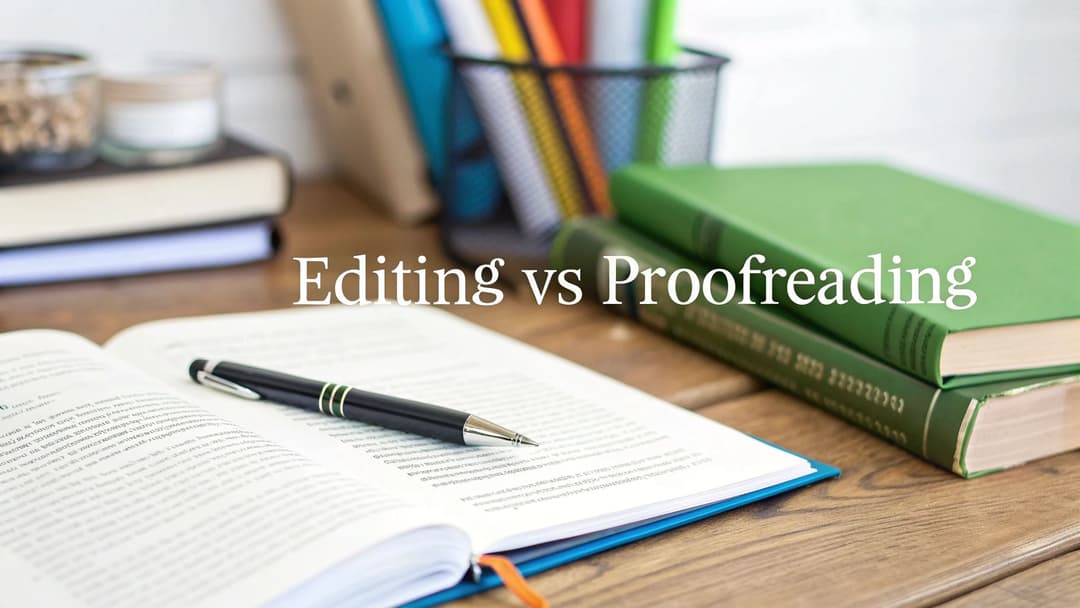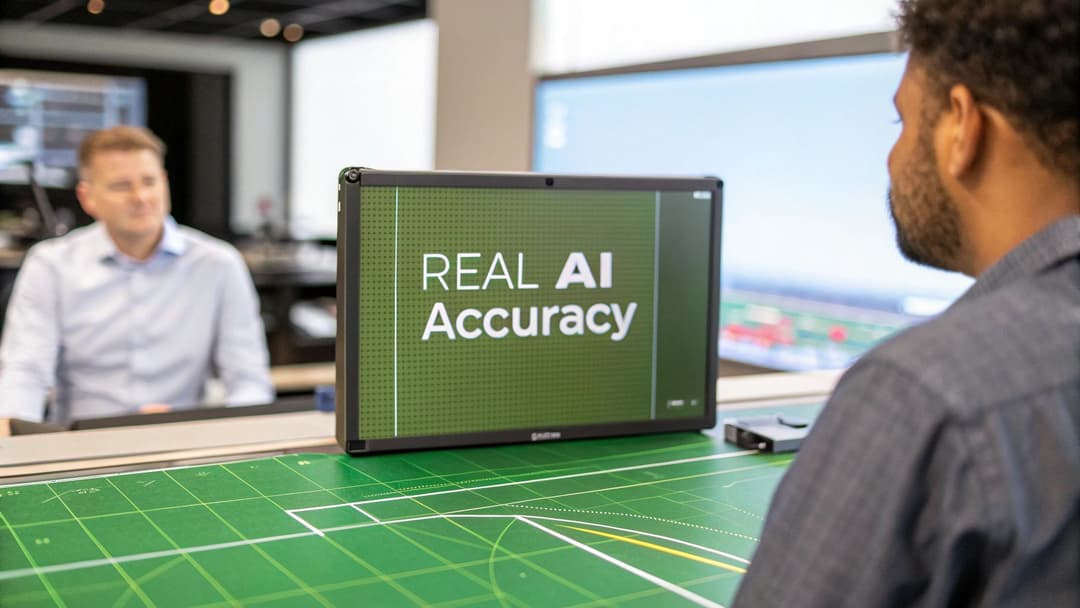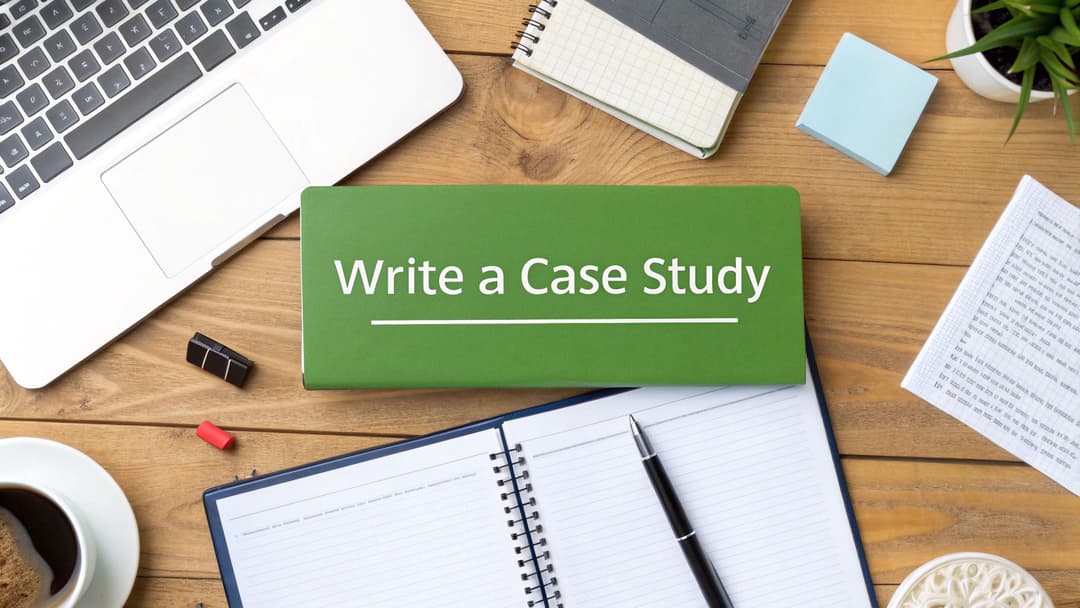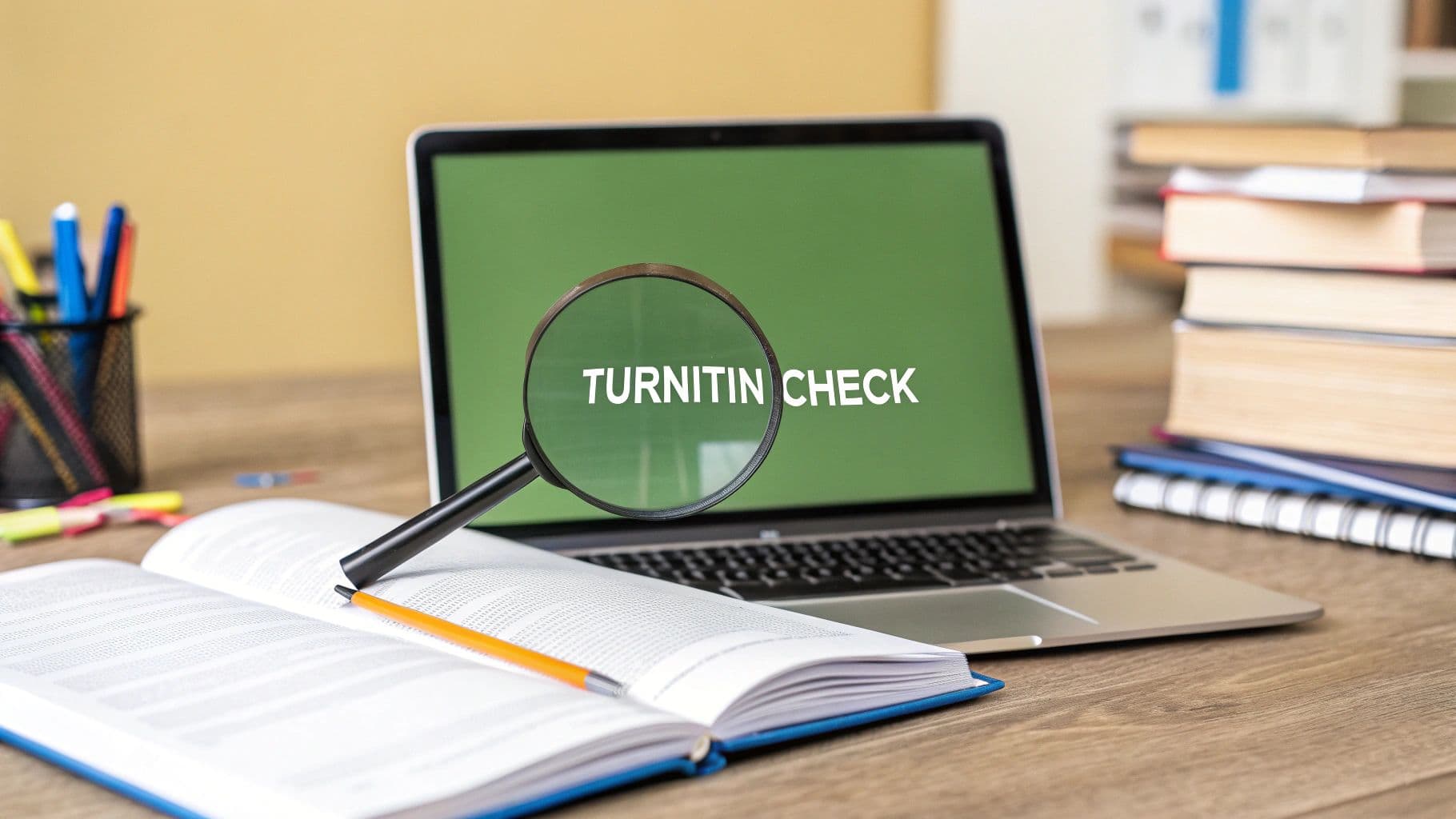
What Does Turnitin Check For? A Complete Guide
October 31, 2025
When you upload a paper to Turnitin, it isn't just looking for one thing. It's running a deep, multi-layered scan that zeroes in on three key areas: text similarity, hints of AI-generated writing, and proper citation. It’s less of a simple “gotcha” tool and more of a powerful guide, highlighting the exact parts of your work that need a second look.
What Turnitin Really Checks at a Glance
A lot of people think Turnitin is just for catching cheaters. And while it definitely helps maintain academic integrity, that’s not the whole story.
Think of it as a sophisticated mirror for your writing. It reflects back the parts of your paper that match other sources, show the statistical fingerprints of AI, or have citation slip-ups. This gives both you and your instructor a crystal-clear picture of your work's originality and how it was put together.
The process is about data, not just a score. An instructor doesn’t simply see a percentage—they see the specific sentences that match an online article, a published journal, or another student’s paper. That context is everything, because a match could be a perfectly cited quote just as easily as it could be a copy-pasted paragraph.
The Three Pillars of a Turnitin Scan
At its heart, Turnitin's analysis is built on three distinct checks. Each one serves a different purpose in evaluating your work. Understanding them helps you make sense of your report and use the feedback to get better.
- Similarity Checking: This is the function everyone knows. It compares your text against billions of web pages, countless academic articles, and a massive library of student papers submitted over the years.
- AI Writing Detection: This is a newer feature that’s all about patterns. It analyzes writing style, word choice, and sentence structure to spot the tell-tale signs of AI models like ChatGPT.
- Citation and Grammar Feedback: The system can also be set up to flag citation mistakes, grammatical errors, and other writing mechanics, giving you direct feedback to sharpen your skills.
The screenshot from Turnitin's own homepage drives this home, framing its role as one that supports integrity across education.
It’s a visual reminder that the platform’s goal is to build a culture of academic honesty, not just punish students. It's a full suite of tools designed for feedback and growth.
To really nail this down, the table below breaks down each core function and what it actually means for you.
Turnitin's Core Functions Explained
This table quickly summarizes the main things Turnitin looks at, what it's trying to find, and how you should interpret the results.
| Function | What It Checks For | What the Result Means |
|---|---|---|
| Similarity | Overlapping text with web pages, journals, and student papers. | Highlights matching text, which could be a quote, a common phrase, or potential plagiarism. |
| AI Writing | Atypical consistency, word choice, and sentence patterns. | Flags text that is statistically likely to be machine-generated, requiring instructor review. |
| Citations | Mismatched references, formatting errors, and bibliography issues. | Identifies technical errors in your citations to help you improve referencing skills. |
Ultimately, each function provides a different lens through which to view your work, helping you and your instructor ensure it’s original, well-referenced, and authentically yours.
So, How Does Turnitin's Similarity Check Actually Work?
The most famous part of Turnitin is its similarity check, but it's probably not what you think. It isn't a "plagiarism detector" that finds guilt like a smoking gun. A better way to think of it is as a massive, super-focused search engine built just for academic work.
When you hand in a paper, Turnitin springs into action. It doesn't pass judgment or look for cheating. It simply acts like a digital librarian, methodically cross-referencing every sentence against its enormous databases to find matching text. The entire process is about identifying overlap, not intent.
The system scans your work and compares it against three gigantic pools of information:
- The Internet: Billions of current and archived web pages are in its sights, from major news outlets and blogs to online encyclopedias.
- Academic Publications: Turnitin has partnered with major publishers, giving it access to a huge library of subscription-based journals, books, and scholarly articles.
- The Student Paper Repository: This is the big one. Every paper ever submitted to Turnitin becomes part of a private, constantly expanding database, ensuring a new paper is checked against millions of past student submissions.
This three-pronged scan produces the famous Similarity Score—a simple percentage showing how much of your text matches content found in those sources.
This infographic breaks down how Turnitin analyzes a submission, layering its checks from similarity to AI detection.
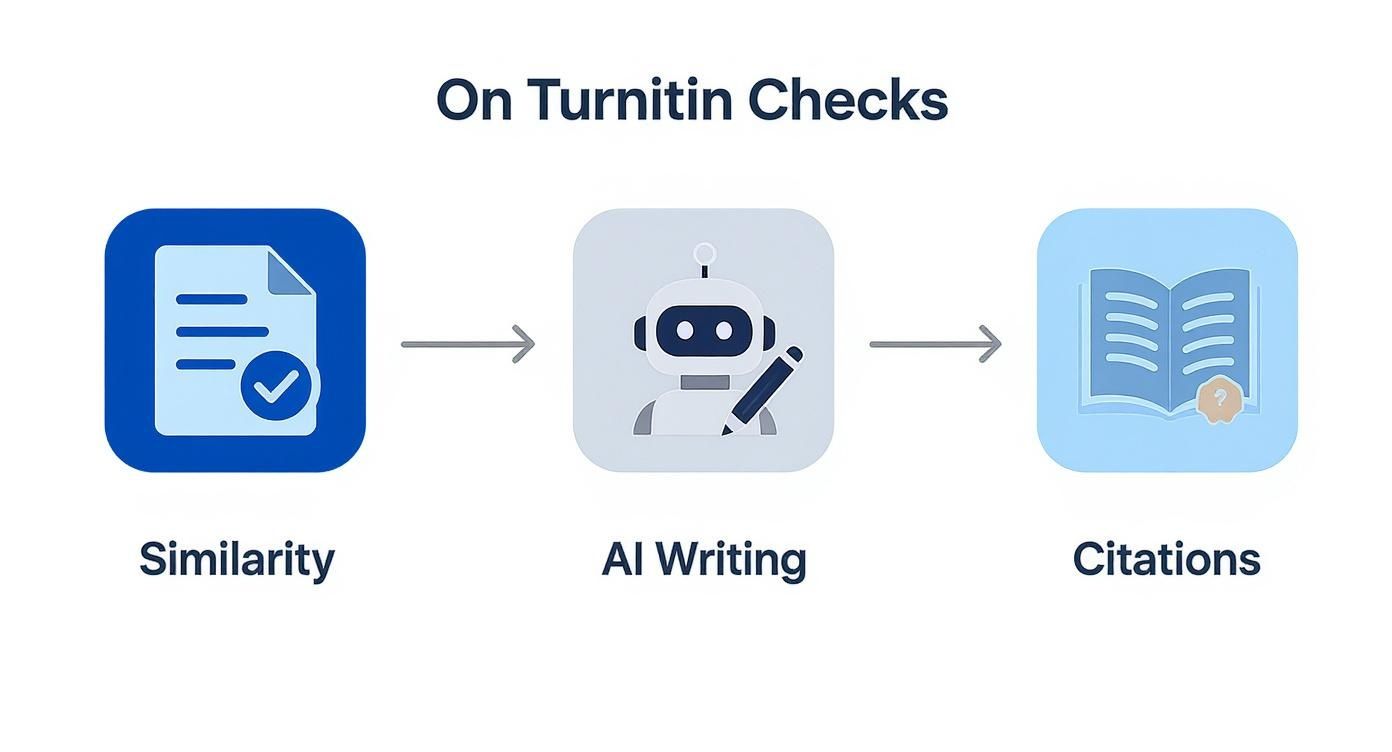
It’s a clear visual of how the tool provides a multi-layered analysis, not just a single, flat score.
What That Similarity Score Really Means
Here’s where most people get it wrong. The Similarity Score is not a grade for academic honesty. A high score doesn't automatically mean someone plagiarized. It just flags matching text for a human to review.
Think about it: properly formatted quotes, a works cited page, or even common phrases used in a specific field will all show up as matches. It's the instructor's job to look at the highlighted sections in the Similarity Report and decide if the matches are legitimate or if they represent unoriginal work.
The key takeaway is this: Turnitin provides data, not a verdict. It flags potential issues for an educator to investigate, helping them separate correctly cited material from text that might need a rewrite or points to a bigger problem.
This has been Turnitin’s core job since it launched way back in 1998. Its power has always been in highlighting text matches for educators, and it now serves over 15,000 institutions by processing billions of papers. For a deeper dive, you can find a ton of additional research on its long-standing role in academia.
Detecting AI Writing in Your Papers
Beyond just matching text from a database, Turnitin's newest and most talked-about feature is its AI writing detector. Think of it as a linguistic detective. It goes way deeper than a simple similarity scan, looking not for copied words, but for the subtle, almost invisible fingerprints left behind by AI models like ChatGPT.
Imagine human writing as a hiking trail through the woods—it twists, it turns, it has an unpredictable rhythm. AI writing, on the other hand, is often like a perfectly straight, freshly paved highway. It’s almost too perfect, too uniform. Turnitin’s AI detector is trained to spot the difference.
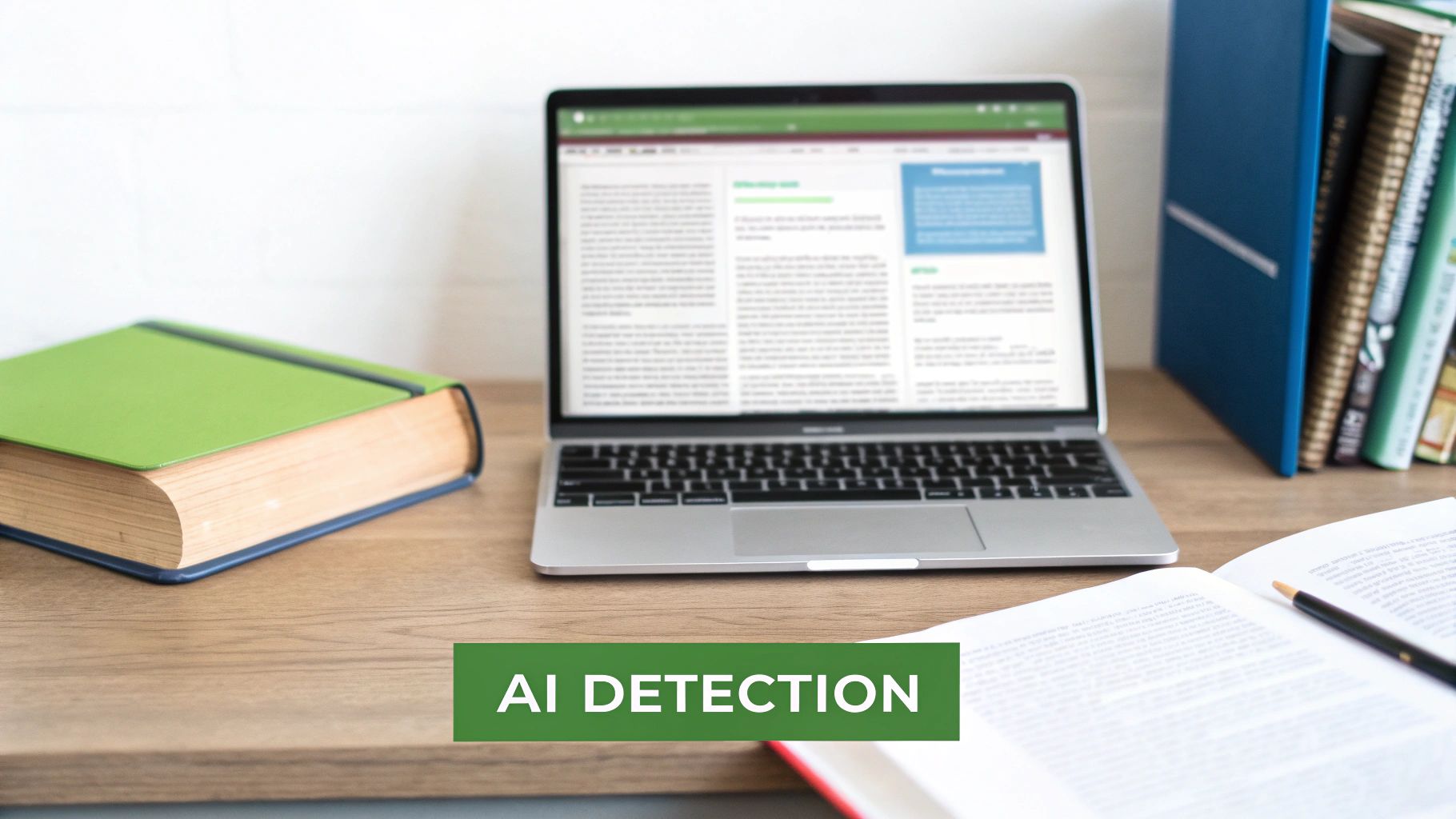
The tool isn't just guessing. It breaks your paper down into small chunks and analyzes each one for tell-tale AI patterns, calculating a probability score for every segment.
How Turnitin Spots AI Fingerprints
The detector is fine-tuned to recognize patterns that are statistically common in machine-generated text. It doesn't rely on a single clue; it looks for a combination of signals that, when found together, point strongly toward AI involvement.
Some of the key indicators it hunts for include:
- Sentence Consistency: AI models often spit out sentences that are suspiciously similar in length and structure. Humans, in contrast, naturally mix it up with short, punchy sentences and longer, more complex ones.
- Word Choice (Perplexity): We all use a mix of common and unexpected words. AI tends to play it safe, sticking to predictable, high-probability word choices that the detector can easily flag.
- Structural Flow: The detector also checks how sentences and paragraphs connect. An overly smooth, almost flawlessly logical flow can actually be a marker of AI generation.
This sophisticated analysis produces an AI writing score—a percentage showing how much of the paper the tool believes was written by an AI. This technology is constantly playing catch-up, of course. As AI models advance, understanding the broader landscape of how they're being used, like in various AI workflow automation tools, gives you a better sense of the challenge involved in detection.
Understanding the AI Score and Its Limits
It's super important to remember that the AI score isn't a smoking gun. Turnitin knows this and has built-in safeguards. The system is intentionally designed not to flag papers with less than 20% AI-generated text to help reduce the risk of false positives. They recognize that drawing a perfect line between human and AI writing is incredibly difficult.
Turnitin claims a 98% accuracy rate for its AI detector. Since its launch, the company has found that over 10% of the millions of papers scanned contain at least 20% AI writing, which shows just how much things are changing in education.
This approach balances some seriously impressive detection capabilities with a healthy dose of caution. For a more detailed look at the mechanics, our guide on whether Turnitin can truly detect AI offers some deeper insights.
Ultimately, the AI report is just one more piece of the puzzle for an instructor to consider when looking at a student's work.
How Academic Trends Reshaped Turnitin
Turnitin didn't just add an AI detector out of the blue. It was a direct response to a seismic shift in how students were writing and, in some cases, cutting corners. For years, the academic integrity conversation was all about one thing: old-school, copy-paste plagiarism.
But as technology evolved, so did the shortcuts.
The explosion of powerful AI writing tools created a problem that was entirely new. Suddenly, the question wasn't just, "Did a student copy this from a website?" It was, "Did a student write this at all?" This change forced Turnitin to become more than just a text-matching tool.
This isn't just a story about software; it's about human behavior. As one form of academic dishonesty became easier to catch, a much subtler one took its place. To stay relevant, Turnitin had to adapt.
The Data Tells the Story
The numbers paint a really clear picture. In the U.S., data from 2023 to 2024 showed that traditional plagiarism flags dropped from 35% to just 17%. That's a massive decrease.
But in that same period, assignments with AI-generated content shot up from 12% to 21%. We’re watching classic plagiarism decline as AI assistance rises—a paradigm shift that tools like Turnitin couldn't ignore. You can dig deeper into these numbers in this 2025 academic integrity report.
This data is exactly why understanding what does Turnitin check for now has to include AI. The platform is simply reacting to what’s actually happening in classrooms.
Why This Matters for Everyone
This new reality has big implications for both students and instructors. For educators, a simple similarity score isn't enough anymore. They need a way to gauge the authenticity of student work in an age where AI can spit out human-like prose in seconds.
For students, it means academic integrity has expanded. It’s no longer just about citing sources correctly. Now, it’s about using AI tools ethically and transparently, in line with your school's rules.
The goal is still the same: uphold academic integrity. But the playbook for getting there has had to change, and fast.
Turnitin’s evolution is a mirror of this new landscape. Adding AI detection wasn't just a shiny new feature—it was a necessary move to keep up.
Improving Your Writing with Turnitin's Tools
While Turnitin is famous for its similarity and AI checks, most people don't realize it has powerful features designed to make you a better writer. It’s not just a watchdog. Think of it as a constructive partner, giving you direct, actionable feedback to help you polish your work before you hit "submit."
This shifts the whole dynamic from just catching mistakes to actively improving your skills. By using these tools, you can strengthen the nuts and bolts of your academic writing, making sure your ideas come across clearly and professionally.
Going Beyond the Similarity Score
Turnitin offers a suite of tools that work like a built-in writing tutor. When your instructor enables them, these features give you instant feedback on the mechanics of your paper, helping you spot issues you might have otherwise missed.
The system’s automated grammar and mechanics checker scans your submission for all the usual suspects. It flags everything from spelling and punctuation mistakes to awkward phrasing and usage, giving you a chance to clean it up. This is a crucial step in learning how to avoid plagiarism because it helps you make sure your own writing is as strong as possible before you even start blending in sources.
Think of it as your first line of defense. This feedback helps you fix technical errors so your instructor can focus on the quality of your arguments, not get bogged down by grammatical mistakes.
Polishing Citations and References
One of the most valuable features is how Turnitin analyzes your citations. It doesn't just look for matches; it actually examines the relationship between your in-text references and your bibliography.
This check can catch common but critical errors:
- Mismatched Sources: It flags citations mentioned in the text that are missing from your final reference list.
- Formatting Errors: It can spot inconsistencies in your chosen citation style, like APA or MLA.
- Unused References: The tool also highlights sources sitting in your bibliography that you never actually cited in your paper.
By flagging these issues, Turnitin helps you build stronger, more credible arguments backed up by correctly attributed sources. Of course, many students also use other tools like Grammarly to get another layer of feedback and really fine-tune their writing before turning it in.
How to Read Your Turnitin Report
Getting your Turnitin report back can be a little nerve-wracking, especially when a big percentage is the first thing you see. But that number is just the start of the conversation, not the final word. Learning to read the full report transforms it from a scary score into a genuinely useful tool for improving your writing.
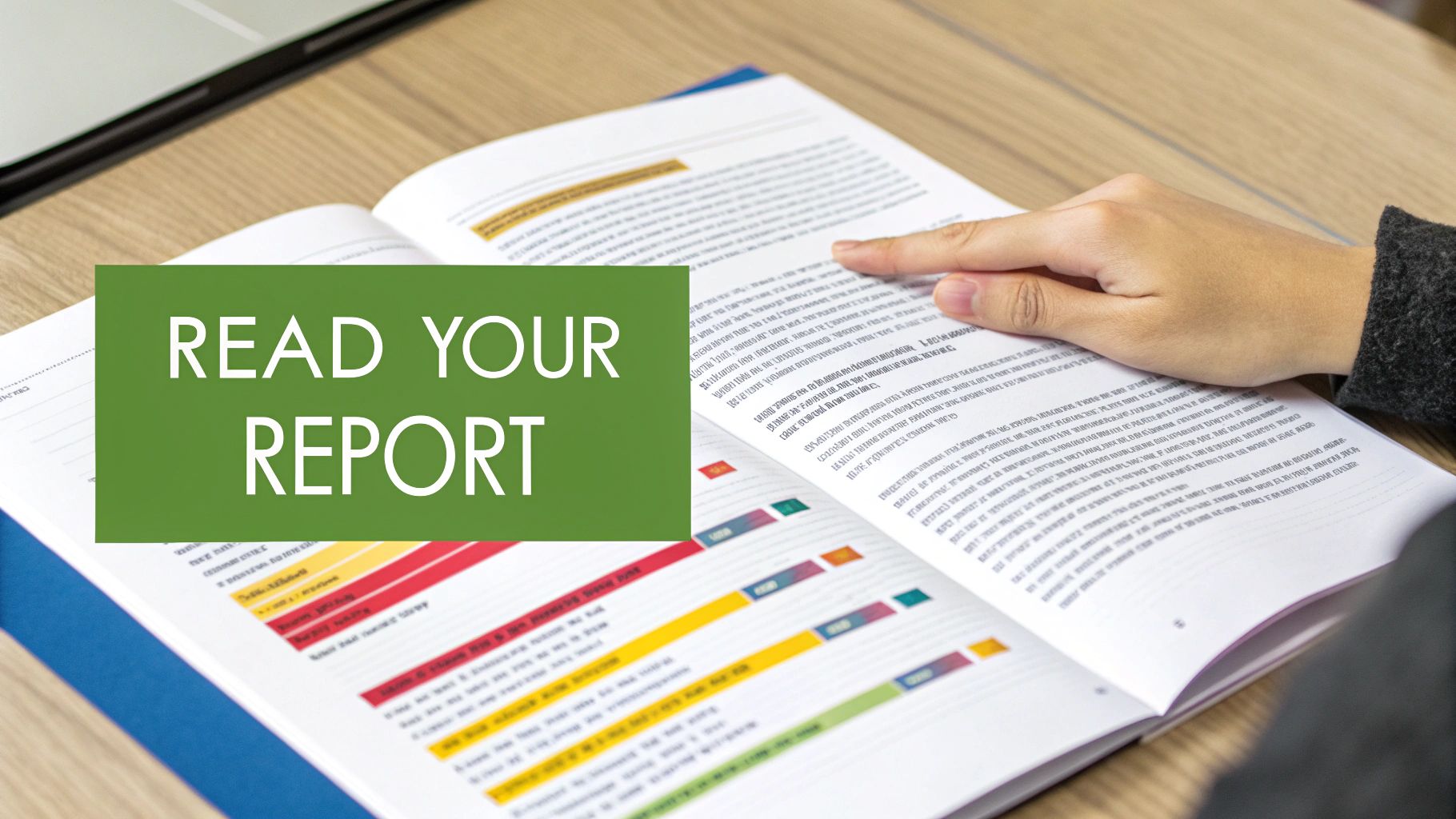
The first thing you’ll probably notice is the color-coded Similarity Score. This gives you a quick, at-a-glance idea of how much matching text the system found in your paper. Think of it as a guide, not a grade.
- Blue (0%): No matching text found. You're in the clear.
- Green (1-24%): A small amount of matching text. This is pretty common and often just picks up on common phrases or correctly cited quotes.
- Yellow (25-49%): A moderate level of matching text. This is where you’ll want to take a closer look at what’s being flagged.
- Orange (50-74%): A high percentage of matching text, signaling that significant chunks of your paper might be unoriginal.
- Red (75-100%): A very high level of matching text. This usually means there's a serious issue.
It’s easy to panic when you see yellow or orange, but understanding the Turnitin similarity score meaning is the key to interpreting your results accurately.
Going Beyond the Percentage
The real value isn’t in the percentage itself—it’s in the interactive details. Don’t just stare at the number. Click on the highlighted passages. This is where the magic happens. You can see exactly what matched and where it came from, which lets you instantly check if a source was cited correctly or if your paraphrase is a little too close for comfort.
The most useful feature by far is the ability to filter your results. You can actually tell Turnitin to ignore your bibliography and any properly formatted quotes. This often drops the score significantly and gives you a much more realistic picture of your original work.
Using the Report for Improvement
Once you’ve filtered out the stuff that’s supposed to be there (like quotes and references), what’s left is your roadmap for revision. The report pinpoints the exact sentences that are too similar to a source, giving you a clear signal to either rework your paraphrasing or add a citation you might have missed.
Think of your Turnitin report as a final check-up before you hand in your paper. By learning to navigate its features, you can catch potential issues, strengthen your arguments, and make sure the work you submit is confidently and truly your own.
Common Questions About Turnitin
Even after you get the hang of how it works, a few practical questions always pop up. Let's tackle some of the most common ones to clear up any confusion about what Turnitin is actually looking for.
Think of this as the FAQ section for your peace of mind.
Does Turnitin Detect Paraphrasing?
Yes, absolutely—especially when it’s not done well. While just swapping out a few words might trick a simpler tool, Turnitin's algorithms are smarter than that. They look at sentence structure, word patterns, and the overall flow.
If your "paraphrased" sentence still follows the original's blueprint too closely, it’s going to get flagged. Its AI detector is also trained to spot text that an AI tool has paraphrased. Good paraphrasing isn't about changing words; it's about digesting an idea and explaining it completely in your own voice. And remember, even perfectly paraphrased content always needs a citation.
Can Turnitin Check Previously Submitted Papers?
It sure can. One of Turnitin’s biggest assets is its massive, private library of student papers submitted from schools all over the world.
When you hand in your work, it’s cross-referenced against this entire archive. This is how it catches students trying to reuse their own work for a different class (self-plagiarism) or submitting a paper written by someone else, even if it was from a past semester or a different university. Your institution’s policy will determine whether your paper also gets added to this database.
Is a High Similarity Score Always Bad?
No, not at all. A high score isn't an automatic red flag for cheating. Context is everything. That number can get inflated by things that are supposed to be there.
The similarity score is just a starting point for review, not a final verdict. An instructor will always examine the report to see why the score is high before making any judgments.
Here are a few perfectly normal things that can push the score up:
- Direct Quotes: Properly cited quotes will show up as a 100% match, as they should.
- Bibliography: Your works cited page is going to match other sources. That's the point.
- Common Phrases: Standard terminology or common phrases in your field can also get flagged.
Instructors know this and can use filters to exclude these matches to get a true picture of your paper's originality.
Ready to ensure your writing is polished, original, and ready for submission? Natural Write offers a free AI checker and humanizer to refine your text, ensuring it meets the highest standards of clarity and authenticity. Check your work at https://naturalwrite.com.
